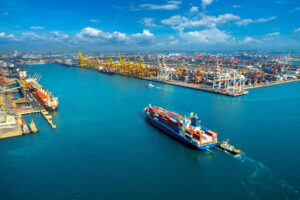Shippers are increasingly frustrated by rate sheets that seem to tell two different stories at once.
In the same week, one corridor might ease noticeably while another holds steady or even rises.
Far from being a mistake, this split reflects how capacity shifts, tariff policies, and congestion pressures play out differently across lanes.
For importers and exporters, the key is recognizing that averages don’t tell the whole story—lane-specific dynamics determine the real cost picture.
Three drivers of the split
Capacity choreography
The container market is still digesting a historic wave of new vessel deliveries. Analysts expect global fleet capacity to increase by approximately 8% in 2025, while demand is projected to rise by about 3%.
On paper, that imbalance should push rates down everywhere. In practice, carriers defend yields by cancelling sailings, known as “blank sailings”, to keep supply tight. Between 15% and 22% of scheduled Asia–U.S. voyages were blanked in April and May 2025.
The outcome is uneven.
On routes with too much tonnage chasing weak demand, rates collapse. But where carriers pull ships aggressively or redeploy capacity elsewhere, supply tightens and prices hold. This “capacity choreography” is the first driver of today’s divergent trends.
Trade policy uncertainty
Layered on top of capacity moves are sudden tariff shifts, which can whip volumes from one corridor to another almost overnight. Earlier this year, a temporary pause in U.S.–China tariff escalation sent a wave of cargo into May and June, only for demand to collapse weeks later once importers had built stock.
Carriers were left mismatched, oversupplied on some eastbound legs, while certain backhaul lanes tightened.
In other words, even if capacity is balanced on paper, tariffs can distort where and when cargo actually moves, amplifying volatility across corridors.
Port timing & congestion pockets
Finally, local disruptions often magnify these broader forces.
Central America and the Caribbean have seen yard congestion worsen as carriers prioritize reefer cargo during seasonal peaks. The Panama Canal remains a chokepoint: drought restrictions and limited slots continue to disrupt schedules, pushing shippers toward costly reroutes.
Northern Europe is facing its own bottlenecks, with labor negotiations in Rotterdam and Hamburg triggering feeder delays across intra-Europe and trans-Atlantic routes.
How these forces show up in practice
The combined effect of these forces doesn’t play out evenly. Instead, it creates a patchwork of “down” lanes where oversupply dominates, and “sticky” lanes where structural limits keep rates firm.
Transpacific: West Coast easing, East Coast lower but variable
The clearest example is the Asia–U.S. trade. According to Xeneta, West Coast spot rates plunged 58% from June 1 to early September 2025, while East Coast rates dropped 46% in the same period. Freightos reports West Coast quotes hovering around $1,725 per FEU, down 1% week-on-week, and East Coast rates at $2,708 per FEU, also edging lower.
Carriers continue blanking sailings to rein in supply, but the sheer scale of available capacity has outpaced cuts. Layer in tariff-driven demand swings, and Transpacific rates remain under heavy downward pressure. For shippers, these “down” lanes show how weak demand plus oversupply can overwhelm carrier attempts at stabilization.
Examples of Sticky or Resilient Lanes: Intra-Americas & Island Services
By contrast, not every lane follows the same script. Certain intra-Americas and island feeder routes stay stubbornly expensive. These corridors often rely on smaller vessel pools, tighter reefer availability, and seasonal demand surges. Caribbean lanes tied to Latin American produce exports, for example, tend to hold firm as reefer volumes peak.
Unlike long-haul trades, these short-sea networks can’t absorb disruption easily. A single blank sailing can squeeze space, leaving few alternatives for shippers. Rates here may not spike dramatically, but they resist falling in line with global averages. In practice, this means shippers must prepare for resilience in some corridors even as headline indices suggest broad softening.
Making sense of the indices without overreacting
The contrast between falling Transpacific rates and sticky intra-Americas lanes highlights why indices should be read carefully. Headline numbers from Freightos, Xeneta, or Drewry are valuable, but they don’t always tell the full story.
For example, a single General Rate Increase (GRI) or a round of blank sailings can push weekly spot rates up by $400–$500 per FEU. Often, those spikes fade within a couple of weeks as demand and supply rebalance. Shippers who chase every swing risk locking into overpriced contracts or misjudging long-term commitments.
A steadier approach is to focus on moving averages: tracking trends across three to six weeks rather than reacting to week-on-week noise. This lens helps distinguish durable shifts from temporary carrier tactics, giving procurement teams a clearer sense of whether rates are truly trending or just fluctuating.
Bottom line: why shipping costs are a patchwork market, not a single story
We have already established that shipping costs in 2025 are diverging by lane. Transpacific routes have slumped under excess capacity and tariff-driven slowdowns, while intra-Americas feeders and congestion-affected ports remain firm.
The key takeaway for shippers is simple: don’t make decisions based on headline indices alone. Rates move unevenly because the drivers play out differently on each corridor.
That means resilience comes from thinking lane by lane. On some routes, early bookings and longer contracts can lock in stability; on others, watching the spot market may save money. In a patchwork market, tailored strategies will keep costs under control.





